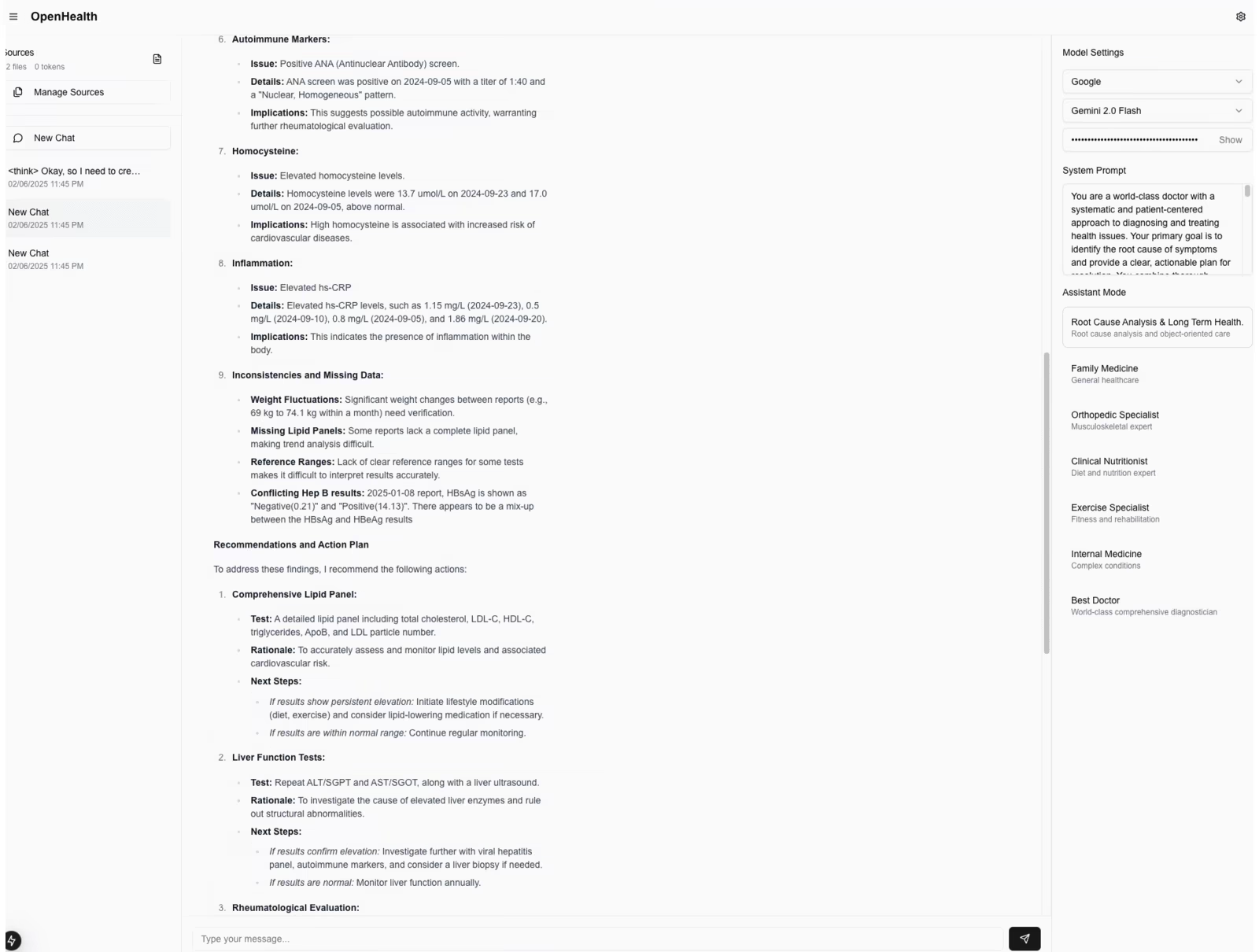AI Health Assistant | Powered by Your Data, Running Locally
OpenHealth helps you take charge of your health data. By leveraging AI and your personal health information, OpenHealth provides a private and locally-run assistant that helps you better understand and manage your health.
Core Features
- 📊 Centralized Health Data Input: Easily consolidate all your health data in one place.
- 🛠️ Smart Parsing: Automatically parses your health data and generates structured data files.
- 🤝 Contextual Conversations: Use the structured data as context for personalized interactions with GPT-powered AI.
| Data Sources You Can Add | Supported Language Models |
|---|---|
|
• Blood Test Results • Health Checkup Data • Personal Physical Information • Family History • Symptoms |
• LLaMA • DeepSeek-V3 • GPT • Claude • Gemini |
- 💡 Your health is your responsibility.
- ✅ True health management combines your data + intelligence, turning insights into actionable plans.
- 🧠 AI acts as an unbiased tool to guide and support you in managing your long-term health effectively.
graph LR
subgraph Health Data Sources
A1[Clinical Records<br>Blood Tests/Diagnoses/<br>Prescriptions/Imaging]
A2[Health Platforms<br>Apple Health/Google Fit]
A3[Wearable Devices<br>Oura/Whoop/Garmin]
A4[Personal Records<br>Diet/Symptoms/<br>Family History]
end
subgraph Data Processing
B1[Data Parser & Standardization]
B2[Unified Health Data Format]
end
subgraph AI Integration
C1[LLM Processing<br>Commercial & Local Models]
C2[Interaction Methods<br>RAG/Cache/Agents]
end
A1 & A2 & A3 & A4 --> B1
B1 --> B2
B2 --> C1
C1 --> C2
style A1 fill:#e6b3cc,stroke:#cc6699,stroke-width:2px,color:#000
style A2 fill:#b3d9ff,stroke:#3399ff,stroke-width:2px,color:#000
style A3 fill:#c2d6d6,stroke:#669999,stroke-width:2px,color:#000
style A4 fill:#d9c3e6,stroke:#9966cc,stroke-width:2px,color:#000
style B1 fill:#c6ecd9,stroke:#66b399,stroke-width:2px,color:#000
style B2 fill:#c6ecd9,stroke:#66b399,stroke-width:2px,color:#000
style C1 fill:#ffe6cc,stroke:#ff9933,stroke-width:2px,color:#000
style C2 fill:#ffe6cc,stroke:#ff9933,stroke-width:2px,color:#000
classDef default color:#000
Note: The data parsing functionality is currently implemented in a separate Python server and is planned to be migrated to TypeScript in the future.
Installation Instructions
-
Clone the Repository:
git clone https://github.com/OpenHealthForAll/open-health.git cd open-health -
Setup and Run:
# Copy environment file cp .env.example .env # Add API keys to .env file: # UPSTAGE_API_KEY - For parsing (You can get $10 credit without card registration by signing up at https://www.upstage.ai) # OPENAI_API_KEY - For enhanced parsing capabilities # Start the application using Docker Compose docker compose --env-file .env up
For existing users, use:
docker compose --env-file .env up --build
-
Access OpenHealth: Open your browser and navigate to
http://localhost:3000to begin using OpenHealth.
Note: The system consists of two main components: parsing and LLM. Currently, parsing utilizes Upstage and OpenAI APIs (which showed the best performance in our testing) with a local parser coming soon, while the LLM component can run fully locally using Ollama.
Note: If you're using Ollama with Docker, make sure to set the Ollama API endpoint to:
http://docker.for.mac.localhost:11434/




